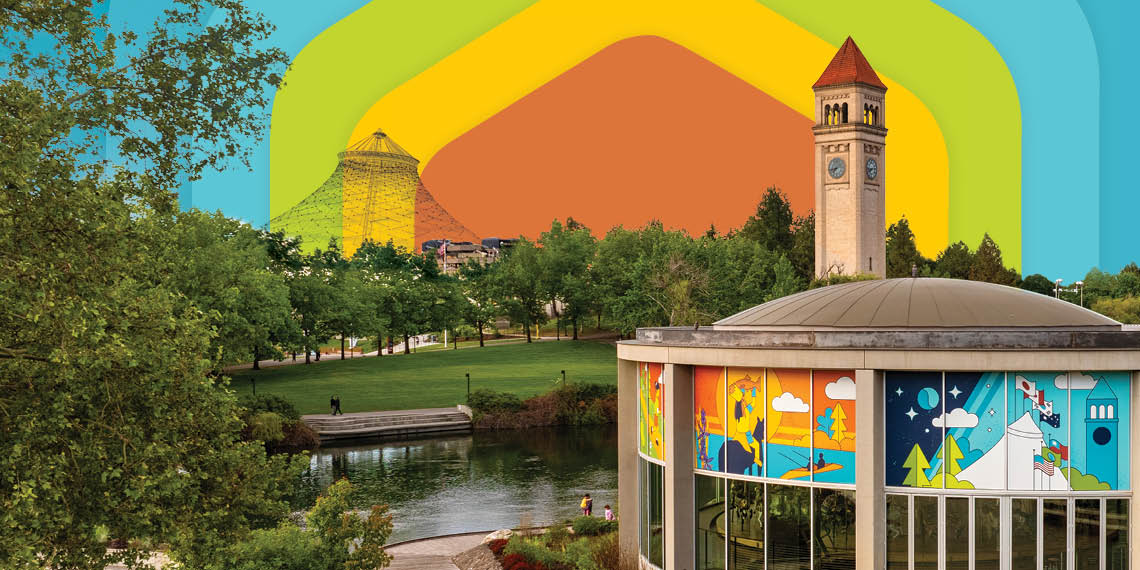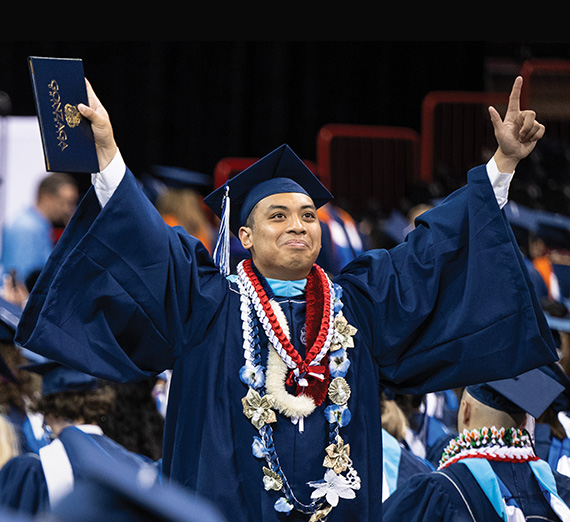How Gonzaga Brought Expo 74 History to Life

In 1974, Spokane stepped up to host the 1974 world’s fair and draw visitors and exhibitors from around the globe to its little dot on the planet.
Expo ’74, through an indefinable communitywide will and the foresight of a man we called King, turned out to be arguably the greatest accomplishment this city had ever pulled off, accounting for cleanup and beautification of the Spokane River, revitalization of the downtown core and the establishment of a magnificent park in the center of our city.

Spokane's Riverfront Park during 1974's World's Fair. (Photo courtesy of Foley Library's University Archives and Special Collections)
The king was King Cole, an urban planner the city hired in 1963 to breathe life back into a city that had lost its luster. Railroad tracks and trestles separated downtown from the river, which was being polluted by a laundry service and other industrial waste that spewed chemicals and other debris into what would become our beautiful waterway.

Under deadlines that seemed insurmountable, the planning took place down to the last minute before Expo opened on a sunny day, May 4, 1974. President Richard Nixon was here to open the six month extravaganza. With Spokane’s business and civic leaders, industry experts, and a colossal effort by ecologists and environmentalists who shaped the sustainability theme of this fair, it all came together.
More than 5 million visitors took in the exhibits staged by Washington and seven other states. The U.S., Russia, China and Japan were among 10 countries represented. Ten corporate and nonprofit partners shined a light on the future, including Ford, General Motors, Eastman Kodak and Boeing.

GU students participated in a demonstration at Expo, calling for President Nixon's removal. While Nixon was president when the 1974 World's Fair opened in May, he had resigned before its completion in November. (Photo courtesy of Foley Library's University Collections and Special Archives)
Entertainment, coordinated by Spokane’s and Gonzaga’s own Mike Kobluk (’60), included such international stars as the conducted by Zubin Mehta, John Denver, Ella Fitzgerald, Bachman Turner Overdrive, Liberace, Up with People and Olivia Newton John.
The impact of the fair in the smallest city ever to host a world exposition didn’t end when the fairground exhibits were packed up and the amusement rides were trucked away. Spokane, its citizens and visitors to this day enjoy the beauty of the Spokane River and Falls from Huntington Park, a pair of footbridges crossing the river near the falls, and a gondola skyride over the raging white waters. The Looff Carrousel has a new home. The Pavilion is an event and performing arts arena. The opera house is now the First Interstate Center for the Arts. The Convention Center expanded and hosts an immense array of events and activities. And all of this current infrastructure is found in a newly updated Riverfront Park.
This spring and summer, the city and a dozen founding partners, Gonzaga University being one, orchestrated a 50th anniversary celebration of the world exposition. The multitude of events and exhibits focused on Expo 74’s five pillars: the Expo legacy, environmental stewardship, tribal culture, recreation and sport, and arts and culture.
GU’s Contributions to the 50th anniversary
Gonzaga students, faculty and staff contributed seven events and/or projects that illuminated the focus on sustainability that was an outgrowth of the fair, and the perseverance it took by many entities to surpass expectations.
Field Trips
History Professor Ray Rast was integrally involved in two events: a field trip to Riverfront Park with Spokane Public Schools students and a readers’ theater performance of "The Heart of a Grand Old Town: The Voices of Expo ’74."
First, the field trip.
Education Professor John Traynor was a “Spokane kid” and remembers his trips to Expo ’74 in a stroller being pushed by his parents. But not much more.
He thought planning a field trip for public school kids to the former world’s fair site would be a perfect project for his Community and Placed-Based class and, with Education Professor Anny Case, thought it well-suited for fourth and seventh graders because both grades study Northwest history.
Traynor sold Spokane Public Schools on the concept and SPS provided bus transportation to Riverfront Park for 5,500 students, with eight visits over four days. Traynor built the tour, picked the sights and developed a passport (map) of the park and each of eight park sites in which GU students would engage the visiting students in conversations about Expo and answer the youngsters’ questions. As it turns out, for many it was their first visit to Riverfront Park.

Any kid is excited for a field trip, but this one was particularly engaging. The Garbage Goat may have been the most popular stop as GU ambassadors provided lots of “trash” for the students to feed to the garbage-eating goat. The younger students also lined the parkway along the Spokane River watching the rushing water begin its downward spill over the rock bed at the falls. One of the park’s newest features, the Ice Age Floods Playground, was also a hit.
Traynor formed a partnership with Rast and his Pacific Northwest history class, which helped staff the field trip sites.
“Ray’s students did the historical research and served as tour interpreters, and I worked with all our student ambassadors on how best to engage with the young students,” Traynor says. “In the end, this project was so authentic and provided lots of learning for our college students. It was community involvement, partnering with the school district and creating opportunities for learning for the school-aged kids. I think our students realized this would not have happened without them and their buy-in.”
Other stops on the tour included the Looff Carrousel, Clock Tower, Pavilion and Snxw mené Island. The was produced by education student Ella Hogan (’26), who says: “The field trip project was better than any of us could have imagined. The kids couldn’t stop asking us about the Expo, the environment and college.”
A team of business students also contributed, researching Expo ’74 and provided materials to Case, who created supplemental curriculum SPS teachers could use before and after the field trip.
Voices of Expo
Before Rast came to GU in 2012, he served as associate director of the Cal State Fullerton Center for Oral and Public History, and always had a desire to “blow the dust off of oral histories and make a script out of them,” he says.
With Expo, he did just that. His students researched and transcribed oral histories given by community and fair leaders relating to the lead up to, and orchestration of, Expo ’74. Histories had been recorded in the early 1990s by author Bill Youngs, who donated his oral histories to the Eastern Washington Historical Society. History Professor Veta Schlimgen recruited a couple of upper-class students to pore over the transcripts and select the best passages to submit to GU’s theater arts students. Under the direction of Professor Leslie Stamoolis, theater students created a script and presented a 40-minute readers’ theatre presentation of “The Heart of a Grand Old Town: The Voices of Expo ’74.” The cast of three students and several theatre craftspeople staged the reading twice in Riverpark Square downtown, and twice at the Northwest Museum of Arts and Culture, where Expo was the focus of its current showcase.
Audiences ranged from young to old, some seeking to know more about how a town the size of Spokane could produce a worldwide exposition, some smiling and reminiscing about their own memories.
The storyline included mafia’s alleged involvement in Expo ’74, planning meetings sometimes fueled by a good deal of alcohol with great accomplishment, and how easy it seemed to secure support from business and civic leaders: “Most who were asked, contributed, often without desire for remuneration,” so remembers one of the characters in the script.
“Voices included leaders as well as common folk and their impressions of the fair and the effort to stage it,” Stamoolis says. “We had nearly 70 students who worked on this presentation in some capacity.”
Sam Morehouse (’24), who is heading off to school in film and TV production this fall, was the scriptwriter. His dad, who was about Sam’s age during Expo, served as an Expo police officer, wore the old-style police uniform and transitioned after the fair to the Spokane Police Department.
“The story, really, is about a small city whose people showed great will to come together and make this fair a reality,” Morehouse says. “We had a few seedy stories, but for the most part, we wove in stories you could smile about.”
Nathaniel Shaffer (’24) served as lead intern for story research, paring down 115 transcribed interviews into 20 pages he handed off to Morehouse for scriptwriting.
“Canada Island, renamed Snxw mené, was absent much vegetation,” Shaffer recalls. “The Canadian government paid for replanting 100 trees. With the fervor and excitement about the fair, money was coming in from many sources. People of Spokane were very generous. The fair made a net gain economically, not the standard for other fairs.”
Climate, Access, Fashion & More
Gonzaga students and faculty created five other events/projects as a tribute to Expo ’74’s legacy.
- The Gonzaga Institute for Climate, Water and the Environment, led by Professor Brian Henning, helped stage a daylong conference on EXPO ’74: 50 Years of Environmental Justice in the Inland Northwest, featuring Environmental Protection Agency Deputy Assistant Administrator Cliff Villa.
- Through the Multidisciplinary Action Projects course in business, students collaborated with the City of Spokane, Parks and Recreation and Avista Utilities to enhance the Spokane River accessibility and recreation opportunities. The group proposed two main ideas: a water taxi service connecting key locations along the river to help alleviate downtown traffic congestion, and a watercraft excursion loop highlighting local culture and history. The group proposes building partnerships with others to ensure efforts continue beyond the students' project timeline, leaving a lasting impact on Spokane's waterfront.
- The Jundt Art Museum featured 81 works and award winners for the Second Inland Northwest Juried Landscape Art Exhibition focused on themes of environmental stewardship, landscape and nature, coinciding with themes of the world’s fair. “The array of styles and materials prevalent in our region provided artists a means of communicating our relationship with nature in an authentic way,” says Paul Manoguerra, museum curator.
- GU’s Spring Dance Concert featured tunes and clothing styles from the 1970s and other references to this environmental-themed world’s fair. All pieces were choreographed by adjunct faculty and performed by students. Dance Professor Suzanne Ostersmith says: “Beatlemania was one theme, another focused on taking care of our people and the Earth. The musical theater group paid tribute to the Looff Carrousel, each dancer in this Mary Poppins-themed number becoming a ribbon-bedazzled dancing horse. The closing act, a ballet to “Bohemian Rhapsody,” brought down the house, complete with mirror ball dropping from the ceiling.”

- A special section of the School of Engineering and Applied Sciences’ Design Expo Day featured seven Expo-themed enterprises: Drinking Water System Resilience to Wildfire; Bringing Netherland’s Sustainable Practices to Gonzaga’s Campus; Spokane Stormwater Quality Improvement Study; Sustainable Airline Seat Cushion Production; Aircraft Interior Parts Recycling; Electric Aircraft Wing Deicing; and Wildfire Resource Simulator.
- Arts & Culture
- Sustainability
- Global Impact
- Academics
- College of Arts & Sciences
- Academic Vice President
- History
- Gonzaga Magazine




